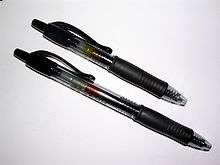Retractable pen

Retractable pens are pens which have a spring-loaded ink cartridge which retracts and extends outside a protective housing. By clicking downward on the top of the pen, the tip is extended and locks in place at the bottom of the housing for use. Pen clicking is repeated pressing of the button of a retractable pen which produces a clicking sound.[1]
History
The origin of the retractable pen is controversial. The Frawley Pen Company, founded in 1949 by Patrick J. Frawley, claims to have made the "first pen with a retractable ballpoint tip" in 1950.[2][3] However, it has also been claimed that the Pilot Pen from Japan was introduced as the first retractable fountain pen, and remains a popular product in the Pilot-Namiki line.[4]

Further, a patent number 3819282 for a retractable pen was filed on November 2, 1972 (published on June 25, 1974) by Penn Corporation (located in Princeton, NJ).[5]
How a retractable pen works
A click pen has several parts to it: the frame, a thruster, two cams, a guide pin, a spring, an ink cartridge with ink, a ballpoint at the end of the cartridge, and other parts that may vary. The spring provides the tension required to retract the ink cartridge. The cams provide a bistable system where in one position the ink cartridge is retracted and in the other it is extended. When the button end of the pen is pressed, the system moves from one position to the other. The guide pin is typically molded into the frame of the pen.
Habitual pen-clicking
In its normal use, the button is only pressed when someone wants the nib of the pen to be exposed so they can write with it. It is impossible to click a pen without the nib of the pen being exposed. This makes a noise, which varies in tone, dynamic and timbre depending on the size and make of the pen. When the noise is heard repeatedly it can sound like a "locust convention",[1] and can have a psychological effect on the doer or anyone in the vicinity. The action can either be a conscious or a subconscious action. It is often associated with boredom, inattentiveness[6] thinking, hiding something, or nervousness. Pen clicking is one type of harassment that can be done while on foot.[7] Clicking pens is one of the physical symptoms of OCD.[8]
It has been described as a nervous habit – a form of fidgeting.[9] It can also be described as a "distracting activity that releases nervous energy".[10]
Some people find it hard to concentrate when others are pen-clicking, and so the action can often be thought of as a pet peeve.
Clicking a pen is a type of autistic stimming behavior, but it is unique in that "a person can do in public without drawing much attention to themselves," as opposed to some others which are not socially acceptable.[11]
In popular culture
- Boris Grishenko (portrayed by Alan Cumming), a henchman from the 1995 James Bond film GoldenEye, is notable for using pen clicking as his signature character quirk. In the film's climax, Bond exploits this habit by switching Boris' pen with a click-activated pen grenade, which in turn leads to the destruction of the villain's base of operations.
- In an ad for Kohl's clothing lines, Jennifer Lopez— who plays a fictionalised version of herself— annoys her colleagues by pen-clicking.[12]
References
- 1 2 "Pen-clicking 'should be investigated'". Australian Broadcasting Corporation. April 1, 2009. Retrieved April 20, 2012.
- ↑ "BALLPOINT PEN". The Great Idea Finder. Retrieved April 25, 2012.
- ↑ "The history of the ballpoint pen". 2002. Retrieved April 25, 2012.
- ↑ Conner, Richard C. (2005). "A history of the pen". Retrieved April 25, 2012.
- ↑ "RETRACTABLE PEN". FreePatentsOnline.com. Retrieved April 25, 2012.
- ↑ Scott, Robin (July 24, 2009). "Stop clicking that pen and other annoying habits". Dalhart Texan. Retrieved April 20, 2012. External link in
|publisher=(help) - ↑ Lawson, David (2009). Cause Stalking. p. 41. Retrieved April 25, 2012.
- ↑ "Help with OCD". Hypnotherapy And NLP In Australia. Retrieved April 24, 2012.
- ↑ "Do's and Don'ts of Phone Interview Etiquette". Retrieved April 24, 2012.
- ↑ "Hand body language". Retrieved April 24, 2012.
- ↑ "Why Does He Flap His Arms Like That?". Retrieved April 24, 2012.
- ↑ "Pen-Clicking Jennifer Lopez Annoys Her Coworkers". E Online. Retrieved April 20, 2012.